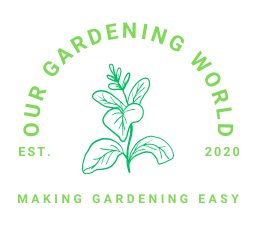How To Get Started With Hydroponic Gardening Introduction
Ever thought about how to get started with hydroponic gardening? Imagine growing your favorite plants without the hassle of soil. That’s hydroponics for you – a soil-less, clean, and efficient way to garden. It’s perfect for everyone, whether you have a green thumb or not!
Understanding Hydroponics
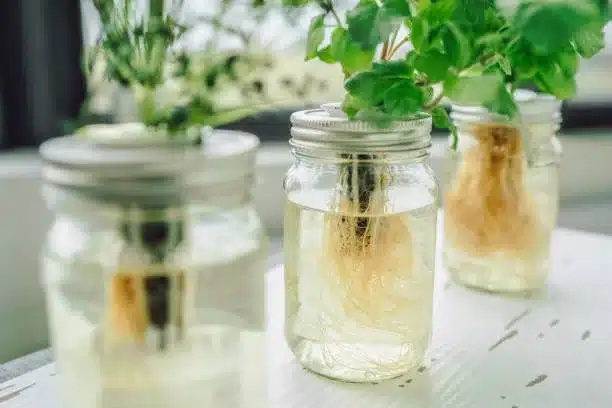
What is Hydroponic Gardening?
Hydroponic gardening? It’s like giving your plants a VIP pass to a nutrient-rich pool party – no soil invited! This method is all about growing plants in a water-based, nutrient-fortified solution. Think of it as a high-tech makeover for traditional gardening. It’s perfect for those wondering how to get started with hydroponic gardening without turning their backyard into a mini-jungle. You get to play mad scientist, mixing nutrients and water to create the ideal growth concoction for your plants. Plus, it’s a space-saver and a conversation starter. “Hey, see my floating lettuce?” – Now that’s a line you don’t hear every day!
Benefits of Starting with Hydroponic Gardening
Starting with hydroponic gardening isn’t just about joining a trendy green movement; it’s like unlocking gardening superpowers! Speedy Plant Growth is your first superpower – plants grow at warp speed compared to their soil-grown cousins, making it a dream come true for the impatient gardener. Then there’s Water Efficiency: you’re practically a water-saving superhero since hydroponics uses way less H2O than traditional methods. And let’s not forget Space-Saving – it’s a small-space dweller’s fantasy. With hydroponics, you can transform even the tiniest apartment into a lush oasis. It’s the perfect answer to the urbanite’s query on how to get started with hydroponic gardening. No backyard? No problem!
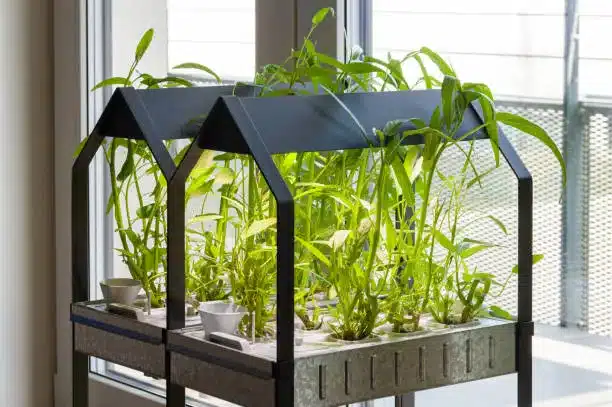
Setting Up Your Hydroponic System
Choosing the Right Hydroponic System
Choosing the right hydroponic system is like picking your favorite ice cream flavor – there’s something for everyone! If you’re wondering how to get started with hydroponic gardening, the first step is to pick your setup.
- The Wick System is the vanilla of hydroponics – straightforward, no-frills, and perfect for beginners. Just wick and grow!
- Then there’s the Ebb and Flow – think of it as the ocean’s rhythm but in your garden. It periodically floods your plants with nutrients, then drains them back, mimicking natural water cycles. It’s like giving your plants their own mini tidal experience.
- For those who prefer a constant nutrient supply, the Drip System is your go-to. It’s like setting up a nutrient IV drip for your plants – they get fed continuously, ensuring they’re always nourished and happy.
- Adventure seekers might opt for the NFT (Nutrient Film Technique). Here, your plants sit in a shallow stream of nutrients flowing under them – it’s like they’re surfing on a nutrient wave!
- And for the tech-savvy gardeners, Aeroponic systems are the sci-fi fantasy of hydroponics. Your plants’ roots hang in the air and get misted with nutrient-rich water. It’s like they’re living in a futuristic spa.
No matter which system you choose, each one offers a unique way to dive into hydroponic gardening and watch your green dreams come to life!
Essential Equipment for Starting Hydroponic Gardening
Embarking on your hydroponic gardening journey is like setting up a backstage for a plant concert, and some key players can’t be missed! First up, the Grow Lights. Think of these as your plants’ personal sun, especially when the real one decides to play hide and seek. These lights ensure your leafy friends get all the ‘sunshine’ they need for photosynthesis, even when the weather outside is doing its best impression of a gloomy British sitcom.
Now, let’s talk about the Pumps and Timers. These are the unseen heroes in the hydroponic saga. Pumps keep the nutrient solution moving like a lazy river in an amusement park, ensuring every plant gets a ride. And timers? They’re like having a smart butler for your plants, automating the feeding schedule so you don’t have to hover around with a stopwatch.
Together, these tools are the dynamic duo in the world of hydroponic gardening. They take the guesswork out of the equation, making sure your plants thrive even if your thumb is more tech-colored than green. So, as you ponder how to get started with hydroponic gardening, remember that with the right grow lights and a trusty pump and timer setup, you’re pretty much ready to turn your space into a green sanctuary. Happy gardening!

Selecting Your Plants for Hydroponic Gardening
Best Plants for Beginners in Hydroponics
- Lettuce: Grows quickly and easily.
- Tomatoes: Perfect for fresh salads.
- Herbs: Enhance your cooking with fresh flavors.
Seed Starting in Hydroponics
In the realm of hydroponics, starting from seeds is like the opening scene of a plant’s life story. When considering how to get started with hydroponic gardening, think of seed starting as your first act of green wizardry. You’ll need some seed starter plugs – these are the cozy little beds where your seeds will take their first nap. Place them in a humidity dome (think of it as a mini greenhouse) to create a snug, moist environment. Then, just add water, a sprinkle of patience, and voila! You’re on your way to growing plants from scratch like a true hydroponic gardener.
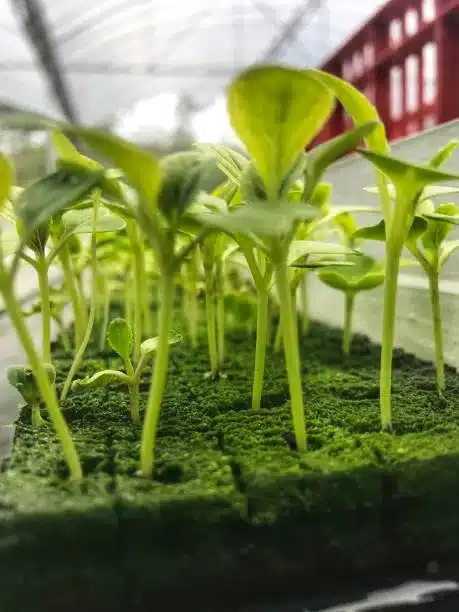
But wait, there’s more! If you already have a plant you’re absolutely in love with and want its twin, welcome to the world of cloning. Cloning in hydroponics is like hitting the copy-paste shortcut on your favorite plant. You simply snip a piece off (politely, of course), dip it in rooting gel or powder, and then place it in a similar cozy bed like the seed starter plug. Keep conditions ideal, and soon, you’ll have a new plant that’s a spitting image of its parent. No need for complex machinery or mad science – just a little bit of plant TLC.
Whether starting from seeds or cloning, each method offers an exciting path to greenery galore in your hydroponic adventure!
Nutrients and Water Management in Hydroponics
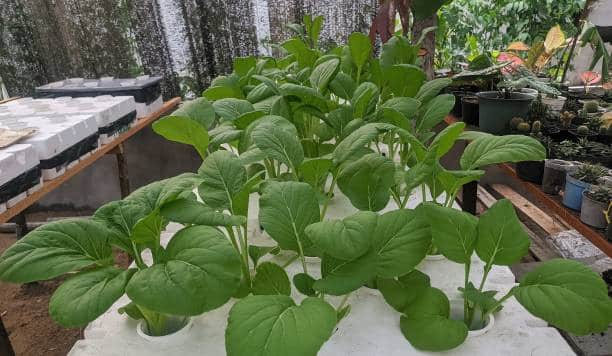
Understanding Nutrients in Hydroponic Gardening
When you’re diving into how to get started with hydroponic gardening, think of nutrients as the secret sauce for your plants. In hydroponics, soil takes a back seat, and it’s all about that nutrient-rich water. There are two types of nutrients that your green buddies will crave: Macro and Micro.
Macro Nutrients are the big players – think of them as the main course in a plant feast. These include Nitrogen (N), Phosphorus (P), and Potassium (K), among others. They’re like the plant version of carbs, proteins, and fats. Nitrogen is like the protein, bulking up those leafy greens; Phosphorus is akin to brain food for your plants, boosting root and flower development; and Potassium is like the plant’s immune booster, keeping them healthy and strong.
Then, there are the Micro Nutrients, the side dishes of the plant world. These include elements like Iron, Manganese, and Zinc. They might be needed in smaller amounts, but they’re like the vitamins and minerals in our diet – vital for the overall well-being of your plants.
Now, about Mixing Nutrients – it’s like being a chef for your plants. You’ll be mixing these nutrients into water to create the perfect nutrient solution. It’s not just about dunking them in any concoction, though. You’ll need to follow specific recipes (provided by nutrient manufacturers) to ensure your plants get exactly what they need for optimal growth. It’s a bit of science, a dash of art, and a whole lot of fun!
So, there you have it. Understanding and mixing nutrients is a critical step in your hydroponic gardening journey – it’s like hosting a gourmet dinner, but for your plants!
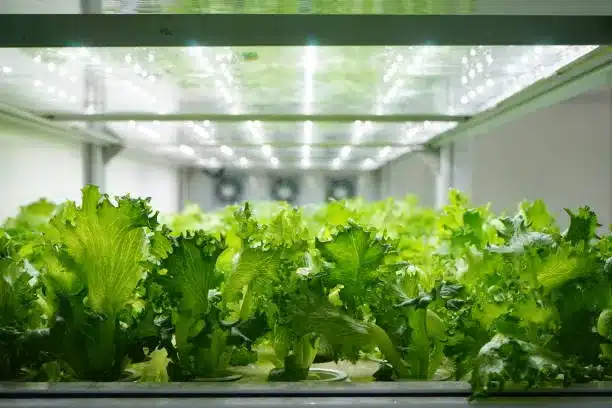
Water Quality and pH in Hydroponics
Diving into how to get started with hydroponic gardening? Let’s talk H2O! In hydroponics, water isn’t just water – it’s the lifeblood of your garden. The quality of water you use is like the difference between giving your plants a gourmet meal or fast food. You want to aim for the finest dining experience, of course!
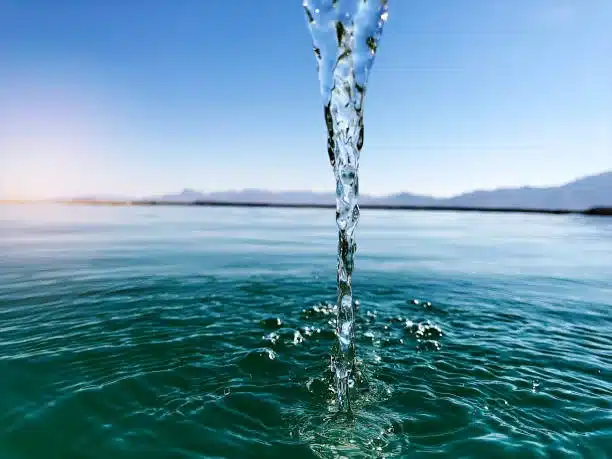
Water Quality Importance can’t be overstated in hydroponics. Using water with impurities is like cooking with stale ingredients – not the best idea. You want clean, pure water as a base. Think of it as the canvas for your nutrient masterpiece. If your tap water is more like a murky pond than a clear spring, consider using a filtration system. Your plants will thank you with lush, vibrant growth.
Now, let’s chat about pH Balance. In the world of hydroponics, pH isn’t just a couple of letters; it’s a critical factor for your plants’ ability to absorb nutrients. Too high or too low, and your plants might as well be on a diet because they won’t be able to take in all those yummy nutrients you’re providing. You’ll want to keep the pH level balanced, typically between 5.5 and 6.5, to create the ideal environment for nutrient uptake. It’s like adjusting the temperature of a bath – get it just right, and your plants will be soaking up the good stuff in no time!
In summary, top-notch water quality and a balanced pH are the dynamic duo of hydroponic success. Keep them in check, and you’re well on your way to a flourishing hydroponic garden!
Lighting and Environment for Hydroponic Gardening
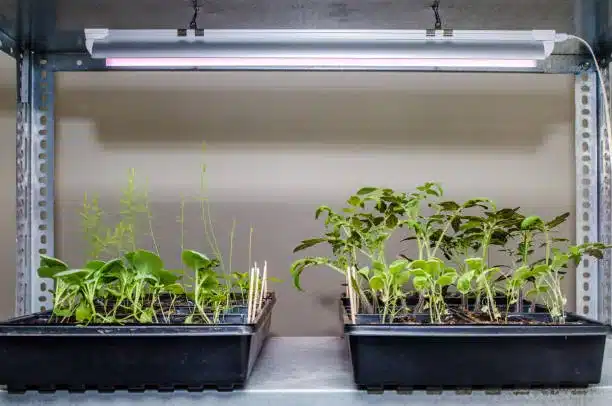
Choosing Grow Lights for Hydroponics
- LED: Efficient and long-lasting.
- HID: Intense light for robust growth.
- Fluorescent: Budget-friendly option.
Maintaining Ideal Conditions in Hydroponics
When you’re on the path of how to get started with hydroponic gardening, creating the perfect growing environment for your plants is like being a weather god for your indoor garden. You’re in charge of setting up the ideal climate, and it’s all about hitting that sweet spot of temperature and humidity.
- Temperature: This is like the thermostat of your plant’s world. Most hydroponic plants thrive in a cozy range of 65-75°F (18-24°C). Too hot, and your plants might start to sweat (figuratively, of course). Too cold, and they might catch a chill. Keep it in the Goldilocks zone – just right.
- Humidity: Think of this as the moisture in the air. Your hydroponic plants love a humidity level around 40-60%. If your indoor garden feels like the Sahara, consider a humidifier to add some moisture. On the flip side, if it’s more like a rainforest, a dehumidifier can help. You don’t want your plants to start thinking they’re on a tropical vacation when they’re not.
Maintaining these ideal conditions is like throwing a party where everyone’s comfortable, no one’s too hot or too cold, and the air is just fresh enough. Your plants will be living their best life, growing happily and healthily. Remember, a happy plant is a productive plant, and in hydroponics, you’re the DJ of the climate party!
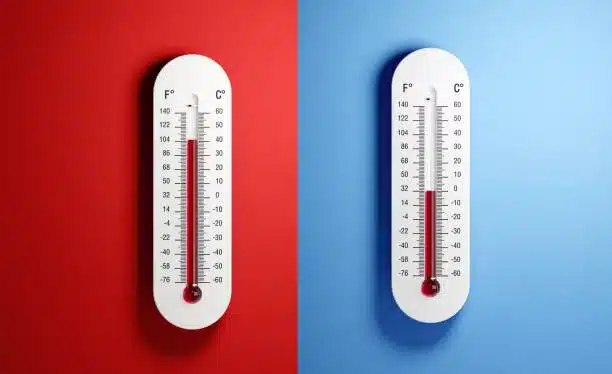
Maintaining Your Hydroponic Garden
Routine Maintenance in Hydroponic Gardening
Stepping into the world of hydroponic gardening isn’t just about setting things up and hoping for the best. It’s more like adopting a pet – it needs your attention daily and a bit of extra TLC weekly. Here’s your routine maintenance playbook:
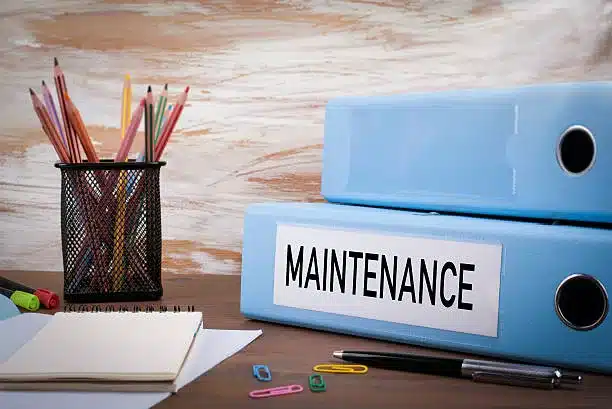
Daily Checks
- Monitor Plant Health: Like a quick health check-up. Are the leaves looking vibrant and green? Any signs of distress or discoloration? It’s like playing detective but with plants.
- System Functionality: Ensure your pumps, lights, and timers are working like a well-oiled machine. It’s a bit like checking if your car’s engine is running smoothly – but for plants.
Weekly Tasks
- Cleaning Equipment: Dust off those grow lights and wipe down surfaces. A clean system is a happy system.
- Nutrient Solution Change: Think of it like refreshing the buffet for your plants. Old nutrient solutions can build up salts that are no bueno for plant health.
- Checking pH and Nutrient Levels: Like a weekly health check for your water. Keep those levels balanced for optimal growth.
Incorporating these routines into your hydroponic journey ensures your plants stay healthy, happy, and productive. It’s a bit like being a plant parent – you nurture them, and in return, they grow. So, as you ponder how to get started with hydroponic gardening, remember: a little maintenance goes a long way in the hydroponic world!
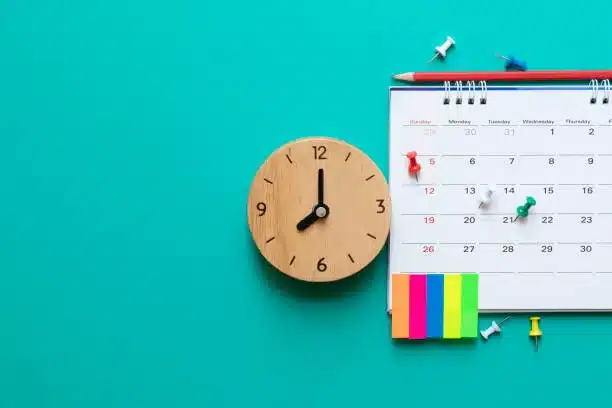
Troubleshooting in Hydroponics
As you navigate how to get started with hydroponic gardening, remember that even in this controlled environment, things can go a bit haywire. But don’t fret; troubleshooting is part of the fun! Here’s how to play plant detective:
Nutrient Issues
- Spotting Deficiencies: Plants are drama queens when it comes to nutrients. Yellow leaves? Might be a nitrogen issue. Purple stems? Could be a phosphorus plea for help.
- Resolving Deficiencies: Once you’ve played Sherlock with your plants, adjust your nutrient mix. It’s like fine-tuning a recipe based on your taste buds, but for your plants.
Pests and Diseases
- Prevention: Keep your garden cleaner than a five-star restaurant. Most pests and diseases are like gatecrashers; they love a messy party.
- Management: If you spot unwelcome guests (like aphids or fungus), act fast. Use organic pesticides or fungicides, and remove affected plants to prevent a plant pandemic.
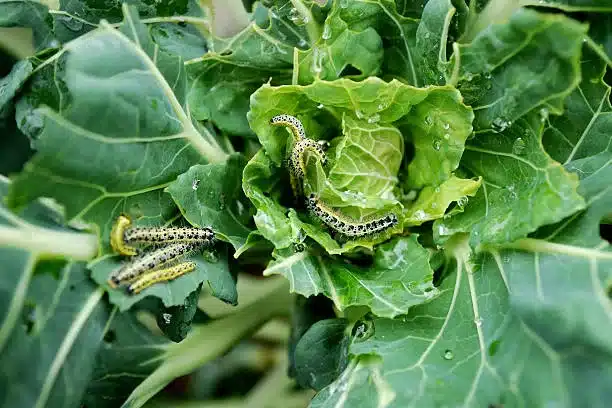
Remember, in hydroponics, being proactive is key. It’s like being on neighborhood watch for your plants. Keeping an eye out for these issues and acting quickly can save your hydroponic garden from turning into a plant horror story. So, as you delve into how to get started with hydroponic gardening, embrace the role of plant guardian – it’s all part of the green-thumbed adventure!
Advanced Hydroponic Gardening Tips
Maximizing Efficiency in Hydroponics
In the quest of how to get started with hydroponic gardening, one of the ultimate goals is to maximize efficiency. It’s like tuning your guitar to get the sweetest melody. Here’s how to crank up your hydroponic system to 11:
Improving Yields
- Pruning: It’s not just a haircut for your plants. Pruning helps direct energy to the most productive parts, boosting yields.
- Optimal Lighting: Like giving your plants a healthy dose of vitamin D. More light (of the right kind) often equals more growth.
- Regular Feeding: Stay on top of your nutrient game. Regularly updating your nutrient solution is like refreshing the buffet for your plants.
System Optimization
- Regular Check-Ups: Treat your system like a car. Regular check-ups and tweaks can keep it running smoothly.
- Upgrading Components: Sometimes, investing in better equipment (like more efficient pumps or advanced lighting) can give you a major boost.
- Space Utilization: Get creative with your space. Vertical setups, for instance, can maximize your growing area.
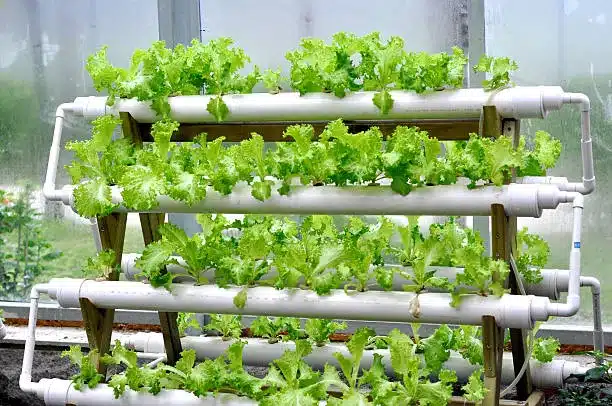
Think of maximizing efficiency in hydroponics as leveling up in a video game. The better you get at managing these elements, the more bountiful your harvest. So, as you dive into how to get started with hydroponic gardening, remember: efficiency is key. It’s like being the manager of a tiny green factory!
Sustainable Practices in Hydroponics
When you’re exploring how to get started with hydroponic gardening, remember it’s not just about growing plants; it’s also about growing them responsibly. Sustainable practices are the cherry on top of your hydroponic sundae. Here’s how to make your hydroponic garden a green (in every sense) paradise:
Water Recycling
- Reusing Water: Hydroponics already uses less water than traditional gardening, but why stop there? Reuse water wherever possible. It’s like giving your water a second life.
- Monitoring Usage: Keep an eye on how much water you’re using. Awareness is the first step towards conservation. You don’t need a flood when a trickle will do.
Organic Nutrients
- Eco-Friendly Choices: Ditch the chemical stuff and go organic. Your plants, and the planet, will thank you.
- DIY Nutrient Solutions: If you’re feeling adventurous, try making your own organic nutrient solutions. It’s a bit like cooking for your plants – homemade and healthy.
Adopting these sustainable practices in hydroponics isn’t just good for your plants; it’s good for the planet. It’s like being an eco-superhero, but instead of a cape, you have a watering can. So, as you delve into how to get started with hydroponic gardening, keep sustainability in your green toolbox. Happy eco-gardening!
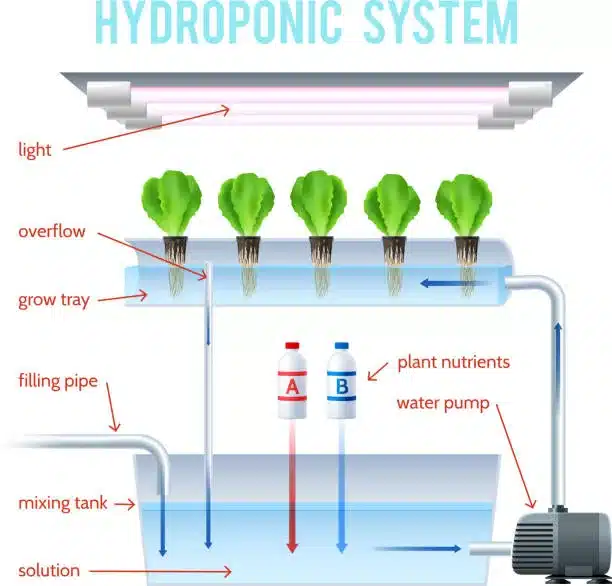
How To Get Started With Hydroponic Gardening FAQ’s
Stepping into the world of hydroponic gardening can be like venturing into a new galaxy. It’s exciting, a bit mysterious, and you probably have a bunch of questions. Well, you’re in luck! Here are some of the most common queries answered to help you get started on your hydroponic journey.
Is Hydroponics Easy for Beginners?
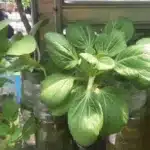
Absolutely! Hydroponics can be very beginner-friendly. It’s like learning to cook – it might seem daunting at first, but once you get the hang of the basics, it’s a breeze. The key is to start simple. Choose a beginner-friendly system (like a wick or water culture system), and begin with easy-to-grow plants. With a bit of patience and some basic maintenance, you’ll be on your way to a thriving hydroponic garden in no time!
What is the Best Hydroponic Garden for Beginners?
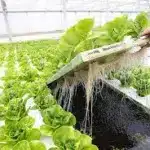
For beginners, the best hydroponic garden is typically one that balances simplicity with effectiveness. A great starting point is the Deep Water Culture (DWC) system. It’s like the training wheels of hydroponic gardening – simple, affordable, and hard to mess up. In DWC, plants are suspended in a nutrient solution, getting a constant supply of water, oxygen, and nutrients. It’s a fuss-free way to start and gives you a solid foundation in the basics of hydroponic gardening.
What is the Easiest DIY Hydroponic System for Beginners?
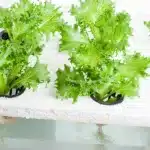
The easiest DIY hydroponic system for beginners is often the Kratky method. It’s like the lazy person’s guide to hydroponics – no pumps, no electricity, just pure simplicity. You’ll need a container, some net pots, a growing medium (like perlite or coconut coir), and nutrient solution. The plants grow in the net pots, suspended over the nutrient-rich solution, absorbing what they need as the water level naturally decreases. It’s a
How To Get Started With Hydroponic Gardening Conclusion
So there you have it, a comprehensive guide on how to get started with hydroponic gardening. It’s a journey filled with learning, experimentation, and undoubtedly a lot of fun. Dive in, get your hands (a little) wet, and enjoy the process of growing your hydroponic garden. Happy gardening!
Check Our Landscape Projects On Facebook
Hi there, I’m Mark Apletree, a gardening enthusiast with a passion for gardening, and gardening tools. I’ll be your go-to guide for all things related to gardening. The purpose of this website is to assist you in selecting the most suitable garden gear that meets your specific requirements.
See All Posts